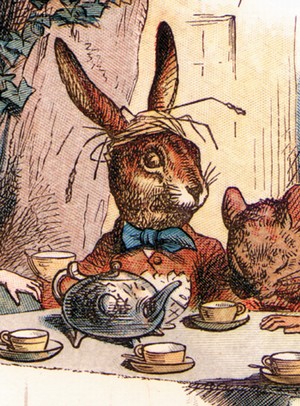
March Hare
The March Hare (called Haigha in Through the Looking-Glass) is a character most famous for appearing in the tea party scene in Lewis Carroll's 1865 book Alice's Adventures in Wonderland.
This article is about the fictional character. For other uses, see March Hare (disambiguation).March Hare
Haigha
Male
Host of the Mad Tea Party
Messenger
The main character, Alice, hypothesizes,
"Mad as a March hare" is a common British English phrase, both now and in Carroll's time, and appears in John Heywood's collection of proverbs published in 1546. It is reported in The Annotated Alice by Martin Gardner that this proverb is based on popular belief about hares' behaviour at the beginning of the long breeding season, which lasts from February to September in Britain. Early in the season, unreceptive females often use their forelegs to repel overenthusiastic males. It used to be incorrectly believed that these bouts were between males fighting for breeding supremacy.[2]
Like the character's friend, the Hatter, the March Hare feels compelled to always behave as though it is tea-time because the Hatter supposedly "murdered the time" whilst singing for the Queen of Hearts. Sir John Tenniel's illustration also shows him with straw on his head, a common way to depict madness in Victorian times.[3][4] The March Hare later appears at the trial for the Knave of Hearts, and for a final time as "Haigha" (which is pronounced to rhyme with "mayor", according to Carroll, and a homophone of "hare" in a non-rhotic accent), the personal messenger to the White King in Through the Looking-Glass (Alice either does not recognize him as the March Hare of her earlier dream, or chooses not to comment about this).
March Hare
Male
Thackery Earwicket
March Hare
Male